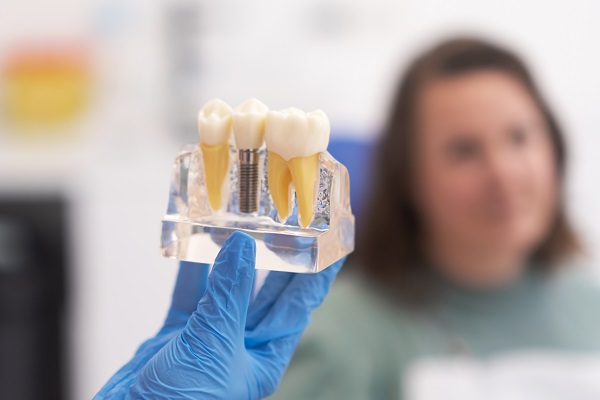Considering dental implants? Read on to learn about the process from an implant dentist. Bone growth and healing are essential parts of the implant dentistry process. It can take time for the bone to grow and heal around the implant after it has been placed, so understanding what to expect and how long it typically takes is a good idea.
An implant dentist explains bone growth and healing after implant placement
The following is a general overview of what you can expect from the dental implant process.
What is the implant placement process?
The implant placement process is a type of minor oral surgery, so sedation is typically used to ensure the patient does not experience any discomfort during the procedure. The procedure involves a small incision into the gums. A small hole is drilled in the jawbone, then the dental implant is placed into the jawbone; the implant is a small, screw-like metal post that fuses with the jawbone naturally after it is properly positioned.
The timeline for bone growth and healing after implant placement
The bone must grow and heal around the dental implant (in a process called osseointegration). This process can take several months to complete. In some cases, it can take close to six months before the mouth fully heals and the abutment and restoration can be placed on the dental implant. The implant dentist can monitor the healing process to ensure there are no setbacks or complications that need to be addressed.
What to expect during the healing process
The healing process can take several months, but any pain or swelling that exists after surgery should go away within a few weeks after the placement procedure. After osseointegration is complete, the implant dentist can schedule a follow-up time with the patient to complete the restoration, which involves attaching the abutment and dental prosthesis (typically a dental crown).
What to do during the growth and healing process
The implant dentist may provide specific oral care instructions to help ensure there are no setbacks during the healing and growth process. Patients may also be required to visit the dentist for regular check-ups and cleaning visits.
How to protect your smile long-term after implant placement
After the second placement procedure to attach the abutment and dental crown (or bridge or denture for multiple tooth replacement), the patient can care for their smile in the same way as they would their natural teeth, which should include a consistent oral care regimen and regular dental cleanings.
FAQ about bone growth and healing after implant placement
The following are several common questions that implant dentists receive on a regular basis, as well as their answers. This information may be helpful in preparing for the implant procedure.
When is a bone graft procedure necessary?
As mentioned earlier, the jawbone must form around and fuse together with the implant, which is known as osseointegration. However, for this natural process to occur, there must be an adequate amount of bone inside of the jaw. Unfortunately, as a result of gum disease and/or bone atrophy, bone loss occurs and is fairly common among individuals with one or more missing teeth. A bone graft procedure is necessary when the bone loss has impacted the ability of the implant(s) to fuse with the jawbone.
What is the success rate of implant placement?
Learning about the osseointegration process for the first time has given some patients pause, questioning the success rate of the procedure. The good news, however, is that almost all patients have a successful experience, and the rate of implant failure is incredibly low. In fact, it is estimated that the success rate of implant placement is around 98% (American Dental Association).
Is implant placement an invasive procedure?
The placement of the dental implants does involve a surgical procedure. This simply means that an incision is made and a small hole is drilled into the jawbone to allow for the placement of the dental implant (or multiple implants for multiple tooth replacement). Although considered surgery, the combination of anesthesia and sedation (if chosen) ensures the patient will only experience minor (if any) discomfort.
The process begins with an implant dentistry consultation
The implant dentistry process begins with a consultation, during which the dentist, their staff, and the patient can put together a comprehensive treatment plan based on the specific needs they have for treatment. To get the process started, call our dental office today to schedule your first visit.
Request an appointment or call Woodside Dental Care at (718) 682-7559 for an appointment in our Queens office.

